Unit 7 Know Our World Lesson 40 Body Language 课件(19张PPT)
文档属性
| 名称 | Unit 7 Know Our World Lesson 40 Body Language 课件(19张PPT) | 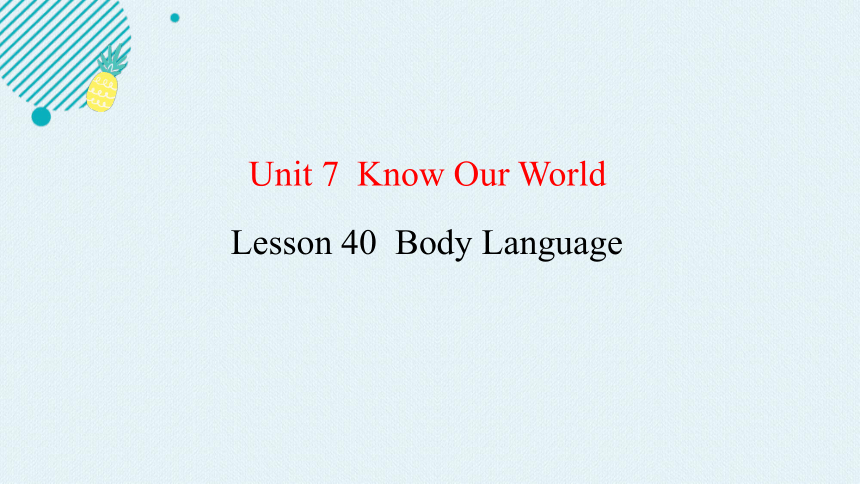 | |
| 格式 | pptx | ||
| 文件大小 | 969.8KB | ||
| 资源类型 | 教案 | ||
| 版本资源 | 冀教版 | ||
| 科目 | 英语 | ||
| 更新时间 | 2025-04-27 16:03:23 | ||
图片预览

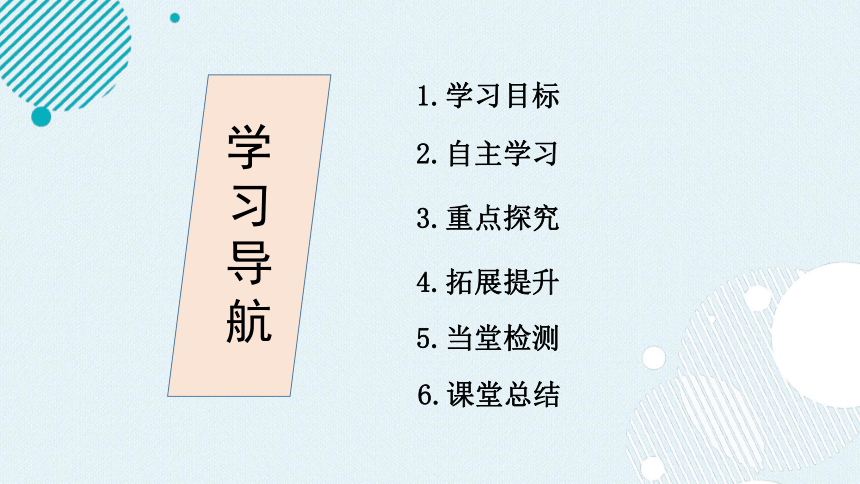
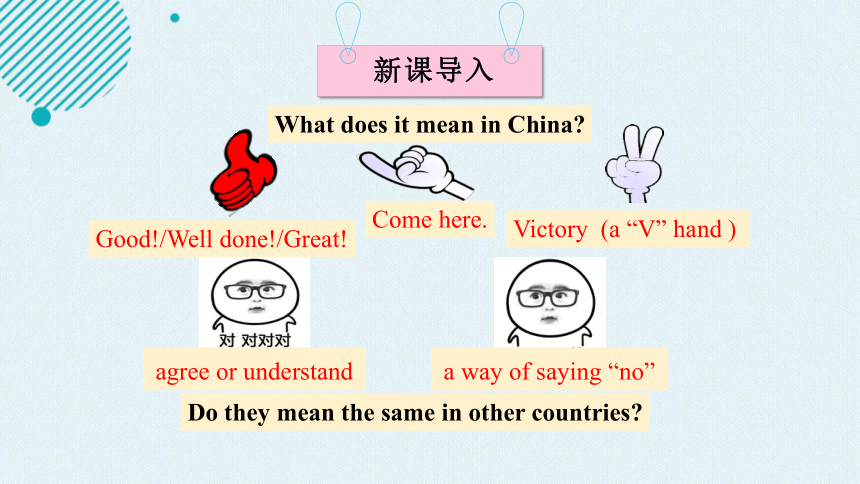
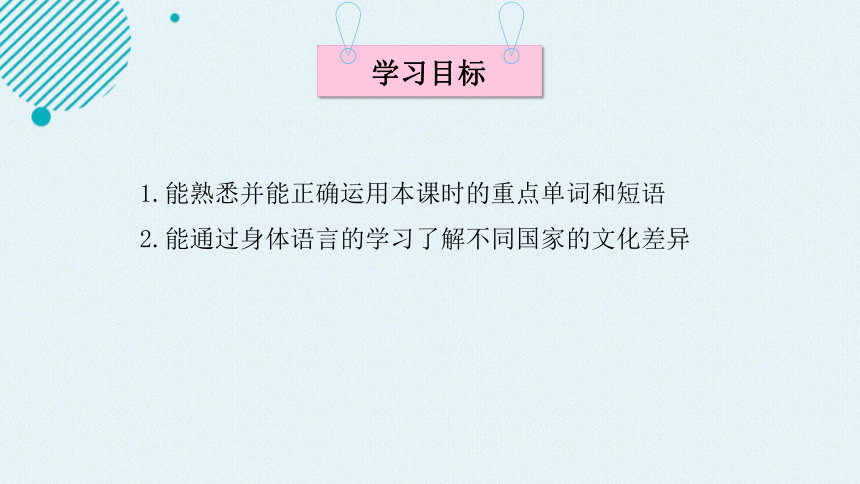
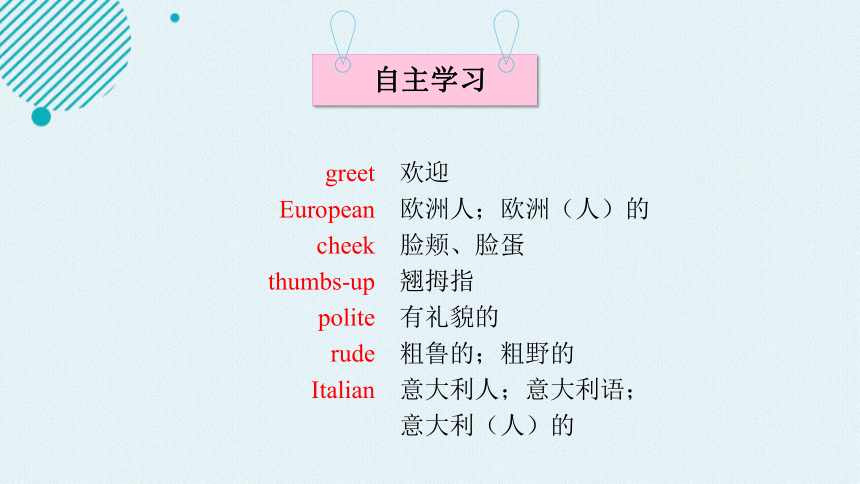

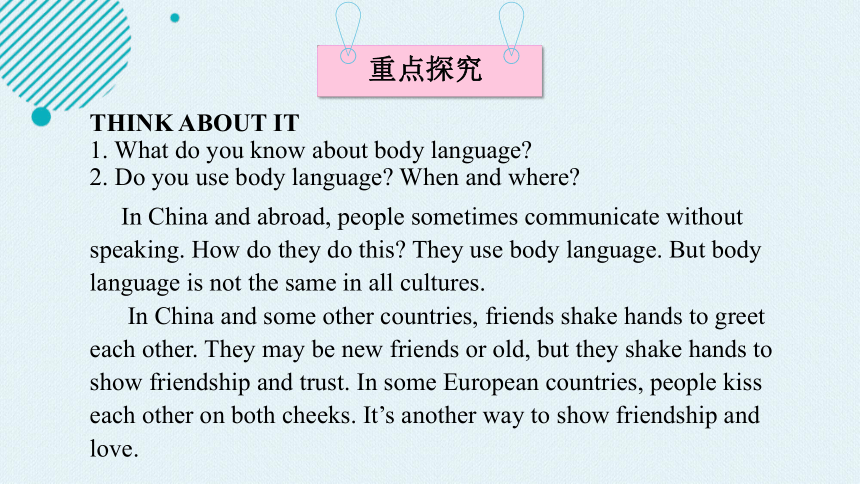
文档简介
(共19张PPT)
Unit 7 Know Our World
Lesson 40 Body Language
1.学习目标
3.重点探究
2.自主学习
学习导航
5.当堂检测
6.课堂总结
4.拓展提升
新课导入
Good!/Well done!/Great!
Victory (a “V” hand )
Come here.
a way of saying “no”
agree or understand
What does it mean in China
Do they mean the same in other countries
学习目标
1.能熟悉并能正确运用本课时的重点单词和短语
2.能通过身体语言的学习了解不同国家的文化差异
自主学习
greet
European
cheek
thumbs-up
polite
rude
Italian
欢迎
欧洲人;欧洲(人)的
脸颊、脸蛋
翘拇指
有礼貌的
粗鲁的;粗野的
意大利人;意大利语;
意大利(人)的
body language
shake hands
greet each other
kiss … on both cheeks
nod heads
shake heads
a thumbs- up
point to with the finger
wave goodbye
It’s polite/ rude to do…
肢体语言
握手
彼此欢迎
亲吻脸颊
点头
摇头
竖拇指
用手指指…
挥手告别
做…是有礼貌的/粗鲁的
重点探究
THINK ABOUT IT
1. What do you know about body language
2. Do you use body language When and where
In China and abroad, people sometimes communicate without speaking. How do they do this They use body language. But body language is not the same in all cultures.
In China and some other countries, friends shake hands to greet
each other. They may be new friends or old, but they shake hands to show friendship and trust. In some European countries, people kiss
each other on both cheeks. It’s another way to show friendship and
love.
In India, when people nod their heads, they mean “no”. And when people shake their heads, they mean “yes”. But in most other countries, these things mean the opposite.
A thumbs-up means “okay” or “well done” in most cultures. In Australia, however, it is not polite. In Japan, it means “five”, and in Germany, it means “one”.
In most places, people point to things with their fingers. But in some places, people point with their lips. They think it's rude to point with a finger.
When Italians wave goodbye, it may look like “Come here!” to Americans. But the American goodbye wave looks like “no” in many parts of Europe and South America.
One body language is the same all around the world: a smile. Try it,and you’ll see!
Culture Tip
Culture refers to the beliefs, way of life, art and customs that are shared and accepted by people in a particular society. The world has many different cultures. We should learn and respect different cultures.
1. Read the lesson and write true (T) or false (F).
1). In some European countries, people like to kiss each other
to show friendship and love. ( )
2). Nodding your head means “yes” and shaking your head
means “no” everywhere in the world. ( )
3). A thumbs-up means “well done” in Germany. ( )
4). When Americans wave goodbye, it looks like “no” in some
European countries. ( )
T
F
F
T
2. Read the lesson again and complete the table.
Gestures Meanings Countries
shake hands greeting, friendship and trust
friendship and love in some European
countries
nod one’s head yes in most places
in India
shake one’s head yes
no in most places
thumbs-up okay and well done in many countries
not polite
five in Japan
one
in China and some
other countries
kiss
no
in India
in Australia
in Germany
3. Fill in the blanks with the words in this lesson.
The first letter is given.
1). His mother k____ him goodbye every morning when
she leaves for work.
2). A: What do you do when you meet new friends
B: I say hello and s_____ hands with them.
3). If you agree, please n___ your head.
4). Italy is a E________ country. It has a long history.
5). It’s p_____ to say “thank you” when someone helps you.
isses
hake
od
uropean
olite
4. Different cultures have different body language. Work in groups.
One student acts out a kind of body language while the others
guess the meaning.
拓展提升
1. In China and abroad, people sometimes communicate without
speaking.
communicate 是不及物动词,“交流;沟通” 。
常用词组 : communicate with sb.“与某人交流”。
communicate的名词是communication.
eg: You can communicate with him by writing.
without 介词 “不;没有”
eg: Fish can't live without water.
2. But body language is not the same in all cultures.
same 形容词 “相同的,同样的”。当其在句中出现时,前面
必须加the. the same as… “和……相同”。其反义的短语是
be different from “与……不同”。
eg: We are in the same class.
3. In China and some other countries, friends shake hands
to greet each other.
shake hands “握手” shake hands with sb “和某人握手”
eg: We often shake hands when we meet each other.
to greet each other是动词不定式短语做目的状语。
4. Europe 国名,“欧洲” .European adj&n “欧洲的;欧洲
人的” 或“欧洲人”. 其前常加不定冠词a.
eg: France is a European country.
eg: Tom is a European.
5. Italy 国名,“意大利”. Italian. adj&n “意大利人的;
意大利语的”或“意大利人”.
eg: His uncle is an Italian.
6. It's another way to show friendship and love.
a way of doing= a way to do “一种做......的方法 ”
eg: a way of learning English
= a way to learn English
7. But in most other countries, these things mean the opposite.
mean the opposite“含义是相反的”.
eg: Nodding heads and shaking heads mean the
opposite in India.
当堂检测
polite; nod; European; shake hands; culture
1. The lady ________ with my mother just now
2. In the distance , my teacher is her head to show
her agreement.
3. _________like eating beef.
4. There are many different _________ around the world.
5. After getting the prize, the girl said “Thank you!” ________
with smile.
shook hands
nodding
Europeans
cultures
politely
一. 用方框内单词的适当形式填空
二. 连词成句
1. you, do, use ,language,body.
________________________________
2. greet, how each do ,you ,other
__________________________________
3. is ,not ,it ,polite, to ,point ,with ,fingers,
__________________________________.
4. could, please, the, door, me, help, you, open
___________________________________
5.let’s, a, learn, about, song,different cultures
___________________________________ .
Do you use body language
How do you greet each other
It is not polite to point with fingers
Could you please help me open the door
Let's learn a song about different cultures
课堂总结
重点短语:
body language
shake hands
greet each other
kiss … on
both cheeks
nod/shake heads
wave goodbye
It’s polite/ rude
to do sth
重点词汇:
greet,European
cheek,polite
thumbs-up
rude,Italian
Unit 7
Lesson 40
Unit 7 Know Our World
Lesson 40 Body Language
1.学习目标
3.重点探究
2.自主学习
学习导航
5.当堂检测
6.课堂总结
4.拓展提升
新课导入
Good!/Well done!/Great!
Victory (a “V” hand )
Come here.
a way of saying “no”
agree or understand
What does it mean in China
Do they mean the same in other countries
学习目标
1.能熟悉并能正确运用本课时的重点单词和短语
2.能通过身体语言的学习了解不同国家的文化差异
自主学习
greet
European
cheek
thumbs-up
polite
rude
Italian
欢迎
欧洲人;欧洲(人)的
脸颊、脸蛋
翘拇指
有礼貌的
粗鲁的;粗野的
意大利人;意大利语;
意大利(人)的
body language
shake hands
greet each other
kiss … on both cheeks
nod heads
shake heads
a thumbs- up
point to with the finger
wave goodbye
It’s polite/ rude to do…
肢体语言
握手
彼此欢迎
亲吻脸颊
点头
摇头
竖拇指
用手指指…
挥手告别
做…是有礼貌的/粗鲁的
重点探究
THINK ABOUT IT
1. What do you know about body language
2. Do you use body language When and where
In China and abroad, people sometimes communicate without speaking. How do they do this They use body language. But body language is not the same in all cultures.
In China and some other countries, friends shake hands to greet
each other. They may be new friends or old, but they shake hands to show friendship and trust. In some European countries, people kiss
each other on both cheeks. It’s another way to show friendship and
love.
In India, when people nod their heads, they mean “no”. And when people shake their heads, they mean “yes”. But in most other countries, these things mean the opposite.
A thumbs-up means “okay” or “well done” in most cultures. In Australia, however, it is not polite. In Japan, it means “five”, and in Germany, it means “one”.
In most places, people point to things with their fingers. But in some places, people point with their lips. They think it's rude to point with a finger.
When Italians wave goodbye, it may look like “Come here!” to Americans. But the American goodbye wave looks like “no” in many parts of Europe and South America.
One body language is the same all around the world: a smile. Try it,and you’ll see!
Culture Tip
Culture refers to the beliefs, way of life, art and customs that are shared and accepted by people in a particular society. The world has many different cultures. We should learn and respect different cultures.
1. Read the lesson and write true (T) or false (F).
1). In some European countries, people like to kiss each other
to show friendship and love. ( )
2). Nodding your head means “yes” and shaking your head
means “no” everywhere in the world. ( )
3). A thumbs-up means “well done” in Germany. ( )
4). When Americans wave goodbye, it looks like “no” in some
European countries. ( )
T
F
F
T
2. Read the lesson again and complete the table.
Gestures Meanings Countries
shake hands greeting, friendship and trust
friendship and love in some European
countries
nod one’s head yes in most places
in India
shake one’s head yes
no in most places
thumbs-up okay and well done in many countries
not polite
five in Japan
one
in China and some
other countries
kiss
no
in India
in Australia
in Germany
3. Fill in the blanks with the words in this lesson.
The first letter is given.
1). His mother k____ him goodbye every morning when
she leaves for work.
2). A: What do you do when you meet new friends
B: I say hello and s_____ hands with them.
3). If you agree, please n___ your head.
4). Italy is a E________ country. It has a long history.
5). It’s p_____ to say “thank you” when someone helps you.
isses
hake
od
uropean
olite
4. Different cultures have different body language. Work in groups.
One student acts out a kind of body language while the others
guess the meaning.
拓展提升
1. In China and abroad, people sometimes communicate without
speaking.
communicate 是不及物动词,“交流;沟通” 。
常用词组 : communicate with sb.“与某人交流”。
communicate的名词是communication.
eg: You can communicate with him by writing.
without 介词 “不;没有”
eg: Fish can't live without water.
2. But body language is not the same in all cultures.
same 形容词 “相同的,同样的”。当其在句中出现时,前面
必须加the. the same as… “和……相同”。其反义的短语是
be different from “与……不同”。
eg: We are in the same class.
3. In China and some other countries, friends shake hands
to greet each other.
shake hands “握手” shake hands with sb “和某人握手”
eg: We often shake hands when we meet each other.
to greet each other是动词不定式短语做目的状语。
4. Europe 国名,“欧洲” .European adj&n “欧洲的;欧洲
人的” 或“欧洲人”. 其前常加不定冠词a.
eg: France is a European country.
eg: Tom is a European.
5. Italy 国名,“意大利”. Italian. adj&n “意大利人的;
意大利语的”或“意大利人”.
eg: His uncle is an Italian.
6. It's another way to show friendship and love.
a way of doing= a way to do “一种做......的方法 ”
eg: a way of learning English
= a way to learn English
7. But in most other countries, these things mean the opposite.
mean the opposite“含义是相反的”.
eg: Nodding heads and shaking heads mean the
opposite in India.
当堂检测
polite; nod; European; shake hands; culture
1. The lady ________ with my mother just now
2. In the distance , my teacher is her head to show
her agreement.
3. _________like eating beef.
4. There are many different _________ around the world.
5. After getting the prize, the girl said “Thank you!” ________
with smile.
shook hands
nodding
Europeans
cultures
politely
一. 用方框内单词的适当形式填空
二. 连词成句
1. you, do, use ,language,body.
________________________________
2. greet, how each do ,you ,other
__________________________________
3. is ,not ,it ,polite, to ,point ,with ,fingers,
__________________________________.
4. could, please, the, door, me, help, you, open
___________________________________
5.let’s, a, learn, about, song,different cultures
___________________________________ .
Do you use body language
How do you greet each other
It is not polite to point with fingers
Could you please help me open the door
Let's learn a song about different cultures
课堂总结
重点短语:
body language
shake hands
greet each other
kiss … on
both cheeks
nod/shake heads
wave goodbye
It’s polite/ rude
to do sth
重点词汇:
greet,European
cheek,polite
thumbs-up
rude,Italian
Unit 7
Lesson 40
同课章节目录
- Unit 1 Spring Is Coming
- Lesson 1 How's the weather?
- Lesson 2 It's Getting Warmer!
- Lesson 3 Sun Is Rising
- Lesson 4 The Spring City
- Lesson 5 Babysitting on a Spring Day
- Lesson 6 Stories about Spring
- Unit 2 Plant a Plant
- Lesson 7 Planting Trees
- Lesson 8 Why Are Plants Important?
- Lesson 9 Gardening with Mary
- Lesson 10 Make Your Garden Grow!
- Lesson 11 Amazing Plants
- Lesson 12 Danny's Plant
- Unit 3 Animals Are Our Friends
- Lesson 13 Danny's Big Scare
- Lesson 14 Amazing Animals
- Lesson 15 The Zoo Is Open
- Lesson 16 The Pear Escaped
- Lesson 17 Save the Tigers
- Lesson 18 Friendship Between Animals
- Unit 4 The Internet Connects Us
- Lesson 19 How Do You Use the Internet?
- Lesson 20 A Computer Helps!
- Lesson 21 Books or Computers?
- Lesson 22 Travel on the Internet
- Lesson 23 The Internet--Good or Bad?
- Lesson 24 An E-mail to Grandpa
- Unit 5 Buying and Selling
- Lesson 25 Raising Money
- Lesson 26 Cookies, Please!
- Lesson 27 Business English
- Lesson 28 Ms. Liu's Great Idea
- Lesson 29 How to Push a Product
- Lesson 30 A Cookie Sale
- Unit 6 Be a Champion!
- Lesson 31 Don't Fall, Danny
- Lesson 32 My Favourite Record
- Lesson 33 2800 Years of Sports
- Lesson 34 Modern Olympics
- Lesson 35 The Dream Team
- Lesson 36 Classroom Olympics
- Unit 7 Know Our World
- Lesson 37 Let's Learn Geography!
- Lesson 38 The World Is a Big Place
- Lesson 39 Ring Up or Call?
- Lesson 40 Body Language
- Lesson 41 A Class of the World
- Lesson 42 North America
- Unit 8 Save Our World
- Lesson 43 Let's Clean Up!
- Lesson 44 Environment Clubs
- Lesson 45 Let's Sort Garbage!
- Lesson 46 Protect Our Environment
- Lesson 47 Connected to Nature
- Lesson 48 Garbage Is Interesting!
